|
Literature
|
Beyond Bounds:
Intergenerational Relationships in
Science Fiction and Fantasy
|
by Linda Frankel
|
WHY READ OR WRITE
SCIENCE FICTION
and fantasy? It might be because these tales can take you outside
the contemporary context to eras and cultures where the mores and
customs are quite different. It is expected that writers in this
field will search for alternative ways of living and thinking that
might be totally beyond the bounds of today's society. When it
comes to intergenerational relationships, have science fiction and
fantasy met this challenge?
Sometimes it takes courage for a writer just to present the way things
are now -- especially when the story speaks from the viewpoint of a
much vilified and persecuted minority. I have deep respect for
Poul Anderson because he dared to write with understanding of a
boy-lover.
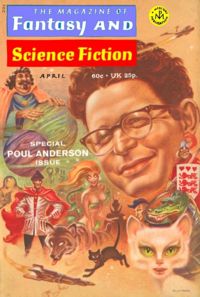 In Anderson's "Eutopia" Iason
Philippou was hunted and persecuted throughout the fantasy society of
Westfall for loving Nikki, a young person whose gender is unspecified
until the story's close. The reader learns that Nikki is really
Nikias, the "most beautiful and enchanting of boys", when Iason has
returned home to a more open society where the strictures of Westfall
are regarded as barbaric. The story leaves us with the impression
that standards are culturally relative, and that it isn't necessary for
a country to behave like the barbarians of Westfall. In Anderson's "Eutopia" Iason
Philippou was hunted and persecuted throughout the fantasy society of
Westfall for loving Nikki, a young person whose gender is unspecified
until the story's close. The reader learns that Nikki is really
Nikias, the "most beautiful and enchanting of boys", when Iason has
returned home to a more open society where the strictures of Westfall
are regarded as barbaric. The story leaves us with the impression
that standards are culturally relative, and that it isn't necessary for
a country to behave like the barbarians of Westfall.
Anderson voiced trepidations in the afterward to "Eutopia". He
feared that he would be persecuted for this story and called
names. The only name I have for him is "maestro".
Vonda McIntyre also wrote with intensity of an intergenerational
relationship between beings of unspecified gender. The adult and
youth in "Wings" are winged hermaphrodites. This story may be
considered disguised and closeted, but there is no doubt of what the
two protagonists felt for each other.
"Mikal's Songbird", a much praised story by Orson Scott Card, showed a
man/boy relationship so tinged with eroticism that the author found it
necessary to deny that they ever had sex. The boy, Ansset, was
the favorite of the Emperor Mikal. This pair is reminiscent of
the real life Roman Emperor Hadrian and his boy love, Antinous.
It is difficult for the reader to evade this knowledge, whatever the
writer may say. When Mikal was overthrown by a rival, all he
asked for was a place where he could retire alone with Ansset for the
rest of his life. Mikal's love is a rebuke to the homophobia of
his creator.
 Another
story of sexless love is "Psi Clone" by Joan Hunter Holly. The
man, ironically named Minor, was a Total Psi. This means that he
was capable of exercising all known powers of the mind. Since
there was no one else like him, the authorities cloned Minor, hoping to
use the clone as a professional world problem solver, like the
original. Minor invested all his vast unfilled needs to be loved
and understood in his clone who grew up in almost complete
isolation. The boy was psychotic, but Minor still hoped he would
be the ideal lover-companion of his dreams. It was with great
sorrow that Minor finally realized that his clone was dangerously
megalomanic and must be killed. Worse, Minor was the only one
able to destroy the boy. Minor's fantasy of romance ended in
death, pain, and inner torment. Another
story of sexless love is "Psi Clone" by Joan Hunter Holly. The
man, ironically named Minor, was a Total Psi. This means that he
was capable of exercising all known powers of the mind. Since
there was no one else like him, the authorities cloned Minor, hoping to
use the clone as a professional world problem solver, like the
original. Minor invested all his vast unfilled needs to be loved
and understood in his clone who grew up in almost complete
isolation. The boy was psychotic, but Minor still hoped he would
be the ideal lover-companion of his dreams. It was with great
sorrow that Minor finally realized that his clone was dangerously
megalomanic and must be killed. Worse, Minor was the only one
able to destroy the boy. Minor's fantasy of romance ended in
death, pain, and inner torment.
A vampire, Count Vardalek, also ended up having to kill the boy he
loved in "The Sad Story of a Vampire" by Count Stenbock.
Vardalek's vampire nature finally overcame his affection. Unlike
Minor, Count Vardalek loses our sympathies. He was a predator,
not a hero. The contemporary media gives the impression that all
boy-lovers are Count Vardaleks. It is impossible to deny that
such individuals exist, but most boy-lovers do no harm to their young
partners. The vampire stereotype represents a calumny.
Sanford Friedman's "Lifeblood" also showed a relationship that began
well and became destructive. The hermaphrodite Agdistis had a
near-idyllic relationship with the boy Attis, but it was marred by
jealousy when the god Apollo also fell in love with the boy. When
Attis died, both Agdistis and Apollo went to Zeus pleading that Attis
be made immortal. Zeus stated that he didn't understand their
obsession with one boy when there were so many others. This
strikes the reader as hypocritical coming from the deity who had to
have no other than Ganymede by his side on Olympus. I imagine
that Ganymede either snickered or dropped in sheer astonishment the cup
of ambrosia it was his duty to bear when he heard these words. In
any case, Agdistis and Apollo were refused and the dead Attis became a
cult.
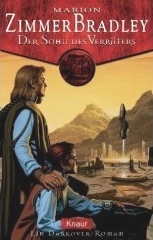 There is a contemporary cult among some of
the fans of Marion Zimmer Bradley's Darkover novels. The most
popular character in the amateur publications, called fanzines, that
deal with Darkover is the endless complex enigma, Dyan Ardais.
Originally a stereotypical villain in the first Darkover novel, The
Sword of Aldones, he grew into a troubled and ambivalent personality
with a strong penchant for boys. He was in addition a respected
leader and the best swordsman of his generation. There is much to
admire about Dyan, but he was no model in his behavior toward
boys. The man was a rapist. No one is certain how many boys
he raped. In Heritage of Hastur he was required to answer for his
abuse of Danilo Syrtis, and some readers would think he was not
punished severely enough. There is a contemporary cult among some of
the fans of Marion Zimmer Bradley's Darkover novels. The most
popular character in the amateur publications, called fanzines, that
deal with Darkover is the endless complex enigma, Dyan Ardais.
Originally a stereotypical villain in the first Darkover novel, The
Sword of Aldones, he grew into a troubled and ambivalent personality
with a strong penchant for boys. He was in addition a respected
leader and the best swordsman of his generation. There is much to
admire about Dyan, but he was no model in his behavior toward
boys. The man was a rapist. No one is certain how many boys
he raped. In Heritage of Hastur he was required to answer for his
abuse of Danilo Syrtis, and some readers would think he was not
punished severely enough.
Many fans believe Dyan was a victim of his society, however. They
feel he was subjected to awful pressures that would have broken a
lesser man. He exhibits a yearning for mutuality in his
relationships with boys, but has given up on attaining it. In
other circumstances, Dyan might have been a better man.
Marion Zimmer Bradley echoed this fantasy in "Ten Minutes or So", a
story that has appeared only in a science fiction convention program
book and in an amateur publication. It took place in an alternate
universe where Dyan decided not to pursue Danilo, but instead responded
to the loneliness of Regis Hastur. Regis was a boy struggling
with his gayness and unable to recover from an earlier gay
relationship. It was clear that Dyan could give Regis the
reassurance he needed to banish the guilt and establish a positive
identity. Dyan also needed Regis badly. At last, here was a
boy who would love Dyan in return. In "Ten Minutes or So" we get
a glimpse of Dyan at his best.
"Darkover Summer Snow," by talented fan writer Eileen Ledbetter, told
the story of Regis' earlier relationship that had left him so shattered
in Heritage of Hastur and in the alternate universe of "Ten Minutes or
So". The essentially heterosexual Lew Alton had sex and
telepathic intimacy with Regis, but then withdrew on the grounds that
he didn't want to hurt the boy, causing Regis more anguish than the
older youth could possibly guess.
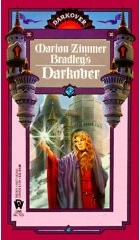 It is interesting to note that "Darkover
Summer Snow" was the first amateur story about Darkover. When
Marion Zimmer Bradley received it, she was so impressed that she
decided to establish Starstone, the first Darkover fanzine.
Starstone has since ceased publication, but other Darkover fanzines
have arisen to fill the gap. In them, fans publish their amateur
writings about Dyan, Regis and other well-loved Darkovans. It is interesting to note that "Darkover
Summer Snow" was the first amateur story about Darkover. When
Marion Zimmer Bradley received it, she was so impressed that she
decided to establish Starstone, the first Darkover fanzine.
Starstone has since ceased publication, but other Darkover fanzines
have arisen to fill the gap. In them, fans publish their amateur
writings about Dyan, Regis and other well-loved Darkovans.
I have yet to see much interest from Darkover fans in Orain from
Bradley's Hawkmistress. Orain fell for the girl-in-disguise
gambit. I don't know why so many novels that deal with girls
disguised as boys have her meet a boy-lover who falls in love with the
disguise. It has become a tired plot formula, but I had to
mention one example.
In comparing Bradley's treatment of intergenerational relationships in
the Darkover novels with the one shown in her circus novel, The Catch
Trap, the same ambivalence is seen throughout. The love between
man and boy is shown as intense and wonderful, but it is always plagued
by doubts and fears. Like Dyan and Regis, neither Mario nor Tommy
in The Catch Trap could achieve unalloyed happiness with each
other. Perhaps this is only realistic. Who in actual life
lives happily ever after?
Daniel Curzon brought realism to the legend of Zeus and Ganymede in
"Mr. Right". Ganymede was portrayed as a cynical hustler
who wanted to know what was in it for him when Zeus proposed a stay on
Olympus. Just when they closed a deal, the Trojan Vice Squad
arrived to arrest Zeus for child molesting. One vice officer
called Zeus a buzzard. Zeus, of course, had been in the form of
an eagle. The old saying about the eye of the beholder was never
truer.
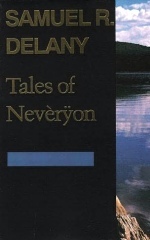 The boy Sarg was no hustler, but
he was purchased on the open market. The problem that marred the
relationship between Sarg and Gorgik, the man who loved him, was
slavery. Gorgik himself had once been a slave and could not
escape from ownership consciousness in his relationship with
Sarg. The stories about this pair, "The Tale of Small Sarg" and
"The Tale of Dragons and Dreamers", in Tales of Neveryon by Samuel
Delany are more notable in their dealing with S/M, but I mention them
here because they are inter- generational. In fact, Sarg was
under the impression that while boys often have sex with each other,
adult men were always heterosexual, and never are attracted to either
men or boys. Gorgik disabused him of this notion. The boy Sarg was no hustler, but
he was purchased on the open market. The problem that marred the
relationship between Sarg and Gorgik, the man who loved him, was
slavery. Gorgik himself had once been a slave and could not
escape from ownership consciousness in his relationship with
Sarg. The stories about this pair, "The Tale of Small Sarg" and
"The Tale of Dragons and Dreamers", in Tales of Neveryon by Samuel
Delany are more notable in their dealing with S/M, but I mention them
here because they are inter- generational. In fact, Sarg was
under the impression that while boys often have sex with each other,
adult men were always heterosexual, and never are attracted to either
men or boys. Gorgik disabused him of this notion.
Heterosexism is exhibited by some science fiction writers, just as it
often is by fictional characters. This is highly unedifying and
we'll hope to see less of it in the future, but Andre Norton, one of
the more prolific writers, showed herself at her homophobic worst in an
interview with Charles Platt published in Dreammakers II. She
seemed particularly concerned that one book would singlehandedly cause
such a panic among librarians that they would cease to order science
fiction and fantasy. She also found it personally offensive,
specifying that it dealt with gay incest. Since I know of only
one novel in the field that fits this description, Andre Norton had to
be referring to The Dancers of Arun by Elizabeth Lynn. Norton had
not one word of praise for this novel's deft characterization or its
inventiveness. All she could see was a piece of smut that ought
to be kept out of the hands of young people.
 I would recommend The Dancers of
Arun to a gay youth without hesitation. The resolution of the
struggles of the boy, Kerris, with alienation and with establishing his
identity might be helpful to other teenagers. His love for his
older brother, Kel, is also an inspiration, since Kerris grows through
the relationship and learns to be non-possessive. I would recommend The Dancers of
Arun to a gay youth without hesitation. The resolution of the
struggles of the boy, Kerris, with alienation and with establishing his
identity might be helpful to other teenagers. His love for his
older brother, Kel, is also an inspiration, since Kerris grows through
the relationship and learns to be non-possessive.
It remained for Hakim to create a boy-love utopia. In Crowstone
the city of Suvyamara seems to have enough willing boys to satisfy any
boy-lover's capacity. Boy-love is considered the preferred form
of relationship and is central to that culture's religion. It is
an intriguing concept. The institutions, customs, and mythology
could be developed more fully, however. On the other hand, there
is a plethora of sex scenes for the delection of aficionados.
Consider that Crowstone is at least three times as long as the average
porn novel and you can easily calculate how much extra eroticism is
packed between those covers. As for those who would like to spend
their next vacation in Suvyamara, I'm afraid it's in a distant galaxy
far away.
I wish there were more woman/girl science fiction and fantasy
novels. Not only is their number few, but their quality is low.
Elizabeth Lynn, whom I praised for The Dancers of Arun, didn't do
anywhere near as well for lesbian korephiles in The Northern
Girl. This ponderous and over-complicated epic loses the
woman/girl relationship, such as it is, in a welter of detail and
intrigue.
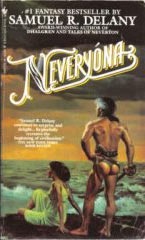 Equally dull is Neveryona by Samuel
Delany. The adventures of the girl hero come alive when she's in
the only major city. There she runs across Gorgik from Tales of
Neveryon and is picked up by the lesbian Madame Keyne, joining the
older woman's all-female household. I've heard it said that
Madame Keyne and the other women in this household behave like men in
drag, but I found the existence of this menage of so much interest that
this didn't bother me. I suppose it matters more if the reader
has a heavy investment in stereotypical differences between lesbians
and gay men. I for one would like to have seen more of Madame
Keyne and company. The heroine left them much too soon. The
rest of the novel had very little to recommend it. Equally dull is Neveryona by Samuel
Delany. The adventures of the girl hero come alive when she's in
the only major city. There she runs across Gorgik from Tales of
Neveryon and is picked up by the lesbian Madame Keyne, joining the
older woman's all-female household. I've heard it said that
Madame Keyne and the other women in this household behave like men in
drag, but I found the existence of this menage of so much interest that
this didn't bother me. I suppose it matters more if the reader
has a heavy investment in stereotypical differences between lesbians
and gay men. I for one would like to have seen more of Madame
Keyne and company. The heroine left them much too soon. The
rest of the novel had very little to recommend it.
In conclusion, I would like to say that this is by no means a complete
survey. There are many more short stories and novels than could
have been included. Even from this small sample it's easy to see
the diversity in the field. Even if science fiction and fantasy
sometimes reflects the taboos of this society, it sometimes transcends
them. Then we have arrived in a freer realm -- beyond bounds.
Bibliography:
Anderson, Poul. "Eutopia" in Dangerous Visions ed. Harlan
Ellison, New York: Doubleday, 1967.
Bradley, Marion Zimmer. Hawkmistress, New York: DAW, 1982.
------------------------ Heritage of Hastur, New York: DAW, 1975.
------------------------ "Ten Minutes or So" in The Darkover
Grand Council Meeting II Program Book, New York, 1979.
Card, Orson Scott. "Mikal's Songbird," Analog, May, 1978.
Curzon, Daniel. "Mr. Right" in The Revolt of the Perverts,
San Francisco: Leland Melott Books, 1978.
Delany, Samuel R. Neveryon, New York: Bantam, 1983.
------------------ "The Tale of Dragons and Dreamers" in Tales of
Neveryon, New York: Bantam, 1979.
------------------ "The Tale of Small Sarg" in Tales of Neveryon,
New York: Bantam, 1979.
Friedman, Sanford. "Lifeblood" in Still Life, New York:
E.P. Dutton, 1975.
Hakim, Crowstone, Amsterdam, Netherlands: Coltsfoot Press, Spartacus,
1983.
Holly, Joan Hunter. "Psi Clone" in Futurelove, New York:
Bobbs-Merrill, 1977.
Ledbetter, Eileen. "Darkover Summer Snow", in Starstone 1,
ed. Marion Zimmer Bradley. Berkeley, CA: Friends of
Darkover, 1978.
Lynn, Elizabeth. The Dancers of Arun, New York: Berkeley Books,
1979.
-------------------- The Northern Girl, New York: Berkeley Books,
1980.
Mclntyre, Vonda. "Wings" in The Alien Condition, ed.
Stephen Goldin, New York: Ballantine, 1973.
Stenbock, Count. "The Sad Story of a Vampire" reprinted in The
Dracula Book of Great Vampire Stories, ed. Leslie Shepard,
Secaucus, New Jersey: Citadel Press, 1977. Originally appeared in
1894.
|
From
NAMBLA Journal Seven,
Pgs. 40 - 42, 1986
|
Copyright © NAMBLA, 2007
|
|
|
|
|

